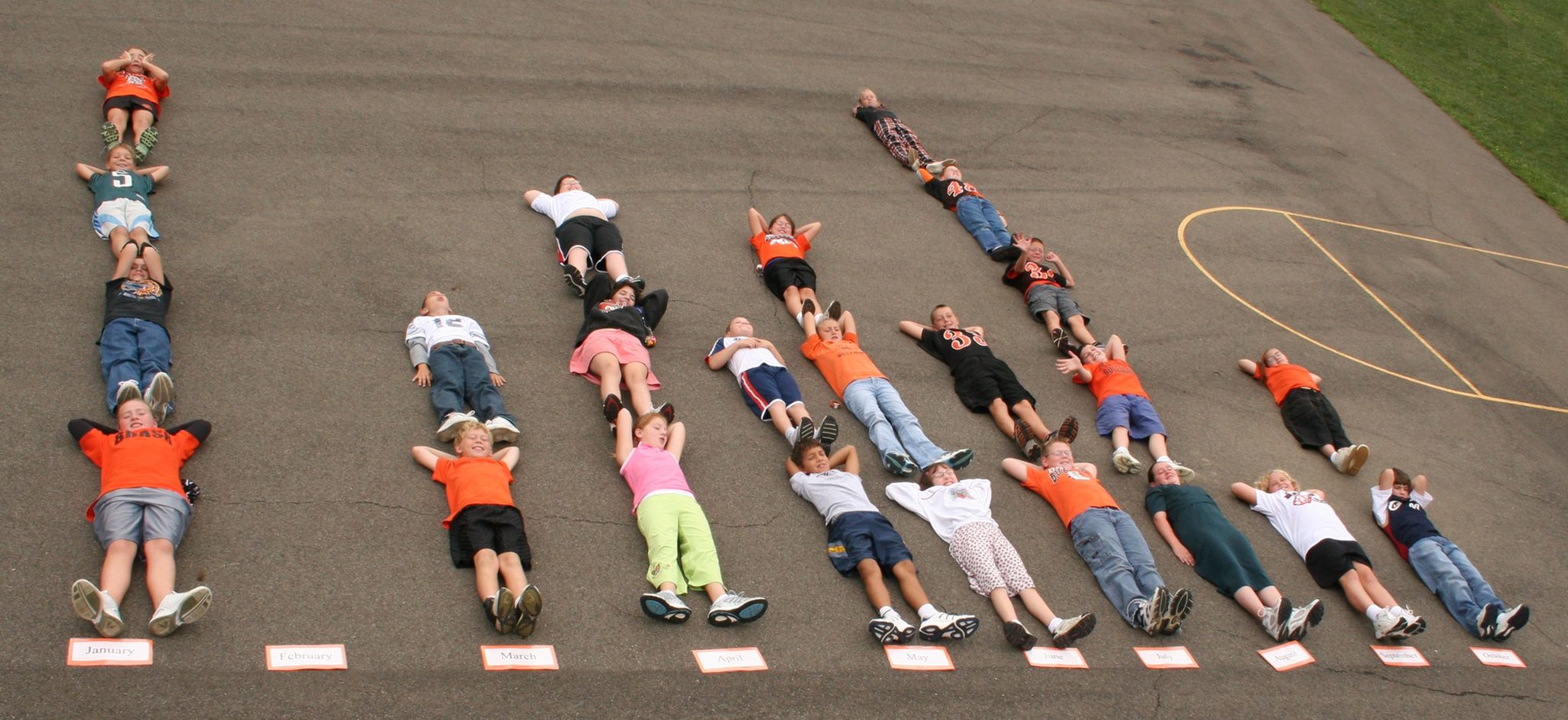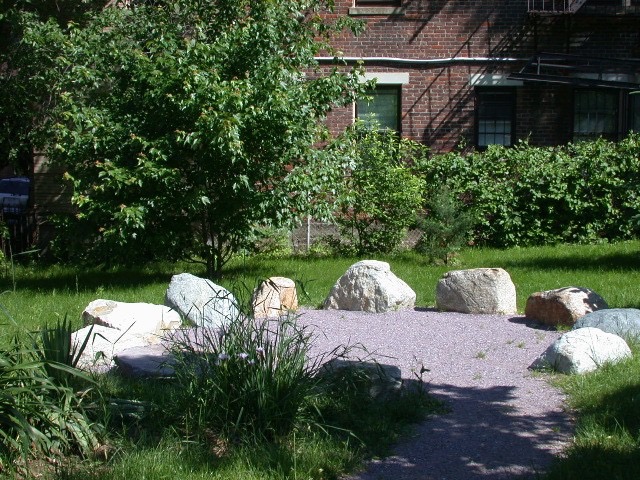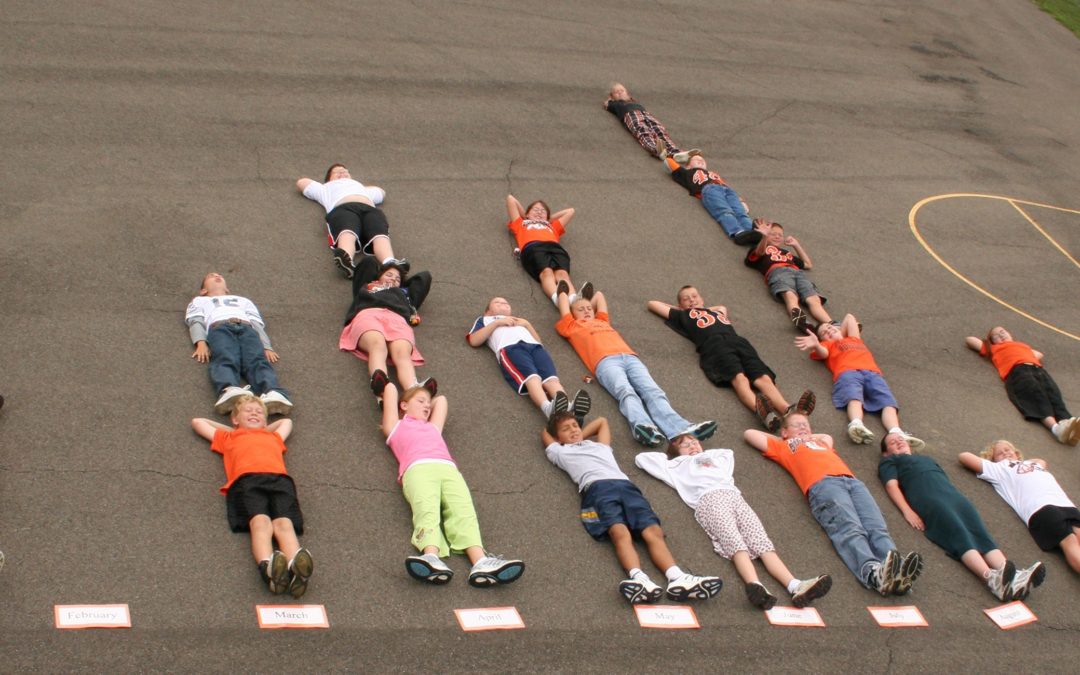By. Herb Broda, Emeritus Professor of Education at Ashland University
We were deep into the measurement unit. Although feet and yards were easy to visualize, the concept of an acre was troublesome. Oh, I dutifully wrote on the board that an acre equals 4,840 square yards, or 43,560 square feet, but the blank looks said it all.
The next day, armed with reels of measuring tape borrowed from the athletic office, we went outside to measure an acre. First, we staked out an acre on the playground. Then we marked an acre on both the football field and the baseball diamond. The impact of these concrete examples was dramatic. Immediately, students began to estimate the acreage of the entire school grounds, as well as the approximate size of their own yards. A concrete outdoor experience had clarified an abstract concept!
Some basic ideas…

Human Bar Graph
Photo | Matthew Broda
In an era dominated by standards and tests, we have to justify the use of the schoolyard as a teaching tool from a pedagogical viewpoint. Let me share with you some of my basic premises about schoolyard learning.
The schoolyard can be utilized either as a venue for learning or as a content source.
When we use the outdoors as a venue, we are just adding a change of pace and place to our teaching. Going outside to demonstrate a principle of physics, to form a human bar graph, or just to read a story are examples of using the outdoors as a venue – we are not studying nature, we are just providing a much needed, and greatly appreciated, change of pace and place.
Often we use the outdoors as a content source. By doing invasive species inventories, using data gathered outside for graphing projects, or focusing on descriptive writing in nature we are now studying or analyzing the outdoors. Both ways of using the outdoors for teaching—venue and content source—are equally useful.
Outdoor learning experiences can be brief.
I feel that the best way to utilize the outdoors is to incorporate brief (15-20 minute) segments that help to clarify abstract concepts being taught indoors. Most classroom teachers do not have time to routinely spend an hour outside. Fortunately, a tremendous amount of learning can take place by using relatively short outdoor excursions.
My favorite example is parallel lines. Use resources inside the classroom to explain the concept of parallel lines – teach the definition, show examples from books and other resources. Then, step outside and find examples of parallel lines in nature. You have provided a change of pace and place, and you have also taken an abstract concept and made it more concrete through examples in the environment.
Outdoor learning relates to all content areas.
I coined the term “schoolyard-enhanced learning” to emphasize the use of the outdoors surrounding the school to enhance instruction in a variety of content areas. Too often, people associate outdoor learning only with science. But the schoolyard is a great place for teaching concepts in math, literacy, social studies, art – actually all content areas. One foreign language teacher even uses the outdoors to teach Spanish vocabulary related to nature!
The schoolyard is a great place to teach process skills.
Process skills are those abilities that cut across content lines and are important in most all fields of study. For example, the ability to analyze information, situations, and/or data is valuable not only in science, but also in social studies, literature, and mathematics. Some process skills common to most areas of the curriculum include: analyzing, observing, describing, classifying, organizing, inferring, predicting, and evaluating. The outdoors is an ideal place to teach these skills.
It is good education!
There are many good pedagogical reasons for using the outdoors as a teaching tool. For a good overview of research regarding children and nature, take a look at the Children and Nature Network’s (C&NN) Research website. C&NN has done an impressive job of collecting current scientific literature related to children and nature. I do not know of a better place to get the most up-to-date research information on this topic.
Although there are lots of sound educational reasons for taking learning outdoors, a few research findings that immediately come to mind include:
- Improved performance on standardized tests of academic achievement in reading, writing, math, science, and social studies.
- Reduced discipline and classroom management problems.
- Increased engagement and enthusiasm for learning.
- Enhanced pride and ownership in accomplishments.
- Increased motivation and opportunities for reluctant learners.
- Decreased stress as a result of being in an outdoor learning environment.
- Strengthened attention spans.
A few schoolyard-learning essentials…
The teaching/meeting area
People often ask, “What is the first thing we should do?” I quickly reply, “Establish a teaching/meeting area!”
The outdoor teaching/ meeting area is more than just a location—it is a powerful classroom management tool. Rather than just running out the door and scattering on the lawn, students know that they are to move directly to the meeting area where they will sit, hear directions for the activity, and receive materials—experiencing an introduction to a lesson just as they would indoors. Since many teachers mention management concerns as a primary reason for hesitating to go outdoors, it is prudent to develop the meeting area first.

Group Seating
Photo | Herb Borda
There are a few essential considerations to keep in mind when developing a teaching/meeting area:
- Keep it close to the building and near an exit door – The less walking time the better.
- Give careful thought to seating – Consider initially using inexpensive materials such as logs, stone blocks, or large rocks.
- Be aware of distractions and student traffic patterns – It is best to avoid a direct line of sight with playground equipment.
- Be aware of sun and shade – If you know there will be a certain time of day when the space will get heavy usage, find a spot that may be a bit sheltered from the sun.
- Provide for special needs – Look at your school population and think about the types of accommodations that need to be made, especially in terms of mobility and access.
Establish some unmowed areas
An unmowed area will quickly attract a variety of plants, small animals, and insects. This type of biodiverse site makes for more interesting observations than just studying the mowed lawn. Keep the site rather small and away from the front of the building or a parking lot. Unmowed areas can look a little rough, which can make maintenance staff uneasy. Some folks legitimize the site by putting up a sign saying “Nature Study Area”.
Plant with biodiversity and the curriculum in mind
The greater the biodiversity of a site, the more plentiful the learning options. Plant trees and shrubs on the school grounds to provide cover and food sources for wildlife. Schools often plant rather formal pollinator gardens, but a bush planted near a classroom window can also encourage critters to come a little closer.
Think about adding some plantings related to curricular concepts. For example, one Ohio family and consumer science teacher has her students plant herbs for use during a foods unit, and a Georgia teacher has a garden that includes the flowers and plants mentioned in several children’s books. Many schools also include plantings that relate to the regional economy or history (e.g., cotton, wheat, or corn). A good example is the Three Sisters Garden that is grown to demonstrate the three main agricultural crops of many Native American groups. One Ohio teacher even plants state flowers for her state and all of the states contiguous to Ohio.
Attract the birds
Birds are probably the largest animals that can be easily and regularly seen in a schoolyard. Take advantage of their abundance and visibility by adding some feeders and houses. A bird feeder outside a classroom window is a good start, and feeders can even be student creations. You have to create a plan for regularly filling the feeders, but that can be a good lesson in responsibility and stewardship. Keep the feeders easily accessible so students can fill them.
Birdhouse and birdfeeder cameras have dropped in price with several options available for under $100. A feeder cam can be very helpful in recording activity at a feeder that is not located near a classroom window. The recorded images can spawn a wide variety of creative and motivating student projects.
***
Schoolyard-enhanced learning is definitely worth the effort! The research continues to point to wonderful consequences of outdoor instruction: children who have frequent exposure to nature are happier, healthier, and smarter.
Outdoor learning is also great for teachers. One elementary teacher summed it up nicely for me: “I’m so enthusiastic when I’m outdoors; and when I’m enthusiastic, the kids are too.”
Let’s go outside!
Copyright © 2016 by Herb Broda
Portions of this essay, and several photographs, are from Moving the Classroom Outdoors by Herb Broda, published by Stenhouse Publishers.
———————————————————————————————————
Herb Broda is an emeritus professor of education at Ashland University. His books, Schoolyard-Enhanced Learning and Moving the Classroom Outdoors, reflect Herb’s passion for helping teachers see ways to use the schoolyard as a teaching tool. He is very concerned about the shrinking amount of time that children (and adults!) are spending outdoors as the ever-present glow of video screens coaxes us to stay inside. Herb’s idea of a perfect day is sharing nature with his family!
Herb’s website is: www.movingtheclassroomoutdoors.com
He can be reached at: hbroda@ashland.edu

